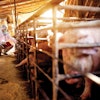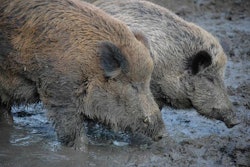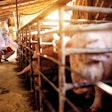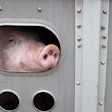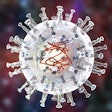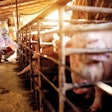
While African swine fever has greatly affected the country, its animal feed market is resilient and analysts expect to see strong growth and stable conditions in 2020.
Although Vietnam has been hit hard by African swine fever (ASF), its animal feed market is dynamic, resilient, highly entrepreneurial and is expected to see strong growth rates and relatively stable market conditions this year.
While nearly half of the country’s pork production has been eliminated by the disease, experts say feed production in Vietnam should be stable in 2020, compared with 2019.
“We’ve already seen most of the industry volume declines,” said John Fering, managing director, Cargill Animal Nutrition, Thailand and Vietnam. “Increases in poultry and aqua feeds have partially compensated for swine feed volume reductions – but with lower feed conversion ratios for those species, they do not fully close the volume gap.
“We expect to bottom out by June or July as the industry fully commits to replenish pig herds. Feed companies offering low-quality feed and limited animal nutrition and health technologies will struggle, since better managed farms are seeking superior feed and services to boost performance,” he said.
Oscar Tjakra, Rabobank’s senior analyst-Asia, said the estimated total animal feed demand in Vietnam was down 10.1% year over year in 2019 due to ASF.
However, he said, “driven by rising prices of animal protein and substitutional effects, other feed species — such as broiler feed, layer feed and aqua feed — will still experience positive growth rates of 5.4% in 2020 in Vietnam. This will help to cushion the lingering impact of ASF to animal feed demand in Vietnam in 2020. Therefore, we expect Vietnam’s animal feed consumption to decrease by 2.1% year over year in 2020 as compared to 10.1% decrease year over year in 2019.”
Investment leads to consolidation, modernization
Small-scale farms and the homemade animal feed sector have been hit hardest by ASF, and larger companies are beginning to invest in smaller ones, causing market consolidation and improvements to biosecurity.
“ASF has affected the feed market in Vietnam mainly through the heavy impact it has had on small pig farms,” said Pierre Domps, marketing and commercial director for ADM Animal Nutrition, Asia. “This has accelerated the consolidation of the market with a shift towards alternative animal production, integration and larger-scale industrial livestock operations.”
Fering added that investments by large companies have improved the market’s competitiveness.
“Large regional agrifoods companies are accelerating investments in breeding farms and integrated protein production to expand their market share in Vietnam domestic markets and to increase options to serve future export opportunities,” he said. “The additional capacity increases the market’s competitiveness.”
Fering said these changes have caused market contraction and modernization.
“Going forward, price signals should spur the industry to increase output using more advanced production techniques and feeding programs,” he said. “Modernization and professionalization, including in genetics, farming, feeding, disease control, transportation and harvesting, are rapidly accelerating.”
That modernization brings with it added biosecurity measures.
“Farmers are being rewarded with record profits thanks to high pig and poultry prices – provided their biosecurity measures are effective and their animals remain healthy,” Fering said. “Farmers improve their odds of success by choosing trusted brands and high-quality products. Feeding programs designed to enhance immune health and maximize animal growth rates are gaining favor.”
Feed quality, safety improvements
Modernization in livestock production will also lead to improved feed quality.
“As more producers modernize in management fundamentals, including environmental, management and animal genetics, the benefits of feeding high-quality feeds will become more apparent.”
Domps agrees that the shift in Vietnam from small-scale to larger-scale industrial farming operations has led to a more sophisticated animal feed sector and a rising demand for high-quality meat.
“With greater sophistication in the local feed sector, producers are also looking for targeted nutritional solutions adapted for the specific developmental stages of animal species,” he said.
He said traceability has also gained more attention.
“Given the ongoing ASF challenge, the traceability of raw materials is an issue that has been gaining prominence,” Domps said. “At the same time, there is a greater emphasis being placed on high standards of quality when it comes to feed products to be used by farmers targeting the export market, especially in aquaculture.”
Fering added that digitalization has gained ground in Vietnam as production becomes more modernized.
“More modern farming systems that use data and farm performance records management help producers observe the relationship between feed quality and overall farm performance,” he said. “We see more interest in the application of digital technologies to help farmers track on-farm performance, making informed decisions in real time.”
But, he said, this modernization requires investment.
“As consumers favor higher quality and premium protein products, farmers will respond by investing to support those supplies. Development of modern retail channels in urban areas is accelerating this trend,” he added.
Increased demand for poultry, aqua feeds
Another effect of ASF in Vietnam is the shift to demand for other species as the pork supply was depleted and some pig farms were converted to poultry farms.
“In areas where risks of (ASF) relapse remain high, re-herding is limited, or for household farms, barns were converted to raise poultry instead,” said Ben Santoso, analyst at Rabobank Singapore.
This has helped the animal feed sector, as the increase in poultry feed and aqua feed demand helps to absorb the impact of ASF, Tjakra said.
Domps said increased demand in other proteins has expanded other segments as well.
“With the swine segment hit by ASF, the poultry sector is leading the growth in the animal feed market and opportunities are emerging for relatively new segments, such as rabbit,” he said. “There has been a growing demand for poultry that includes chicken produced using local breeds, as well as duck and quail. We are also seeing an increasing demand for milk.”
He added that the Vietnamese aquaculture market is gaining prominence, with a focus mostly on freshwater fish and shrimp, driven by domestic consumption and export markets.
To make up for the protein shortfall caused by ASF, the Vietnamese government is looking to increase imports from other countries.
“Increased pork imports from select markets are now permitted as one method to close the protein gap and improve affordability,” Fering said.
Change in consumer demands, government policies
Changing consumer demands and government policies have affected the animal feed production industry in Vietnam as well.
“Vietnamese consumers are now becoming increasingly concerned about how their food is produced. This will impact requirements for quality and traceability of animal feed,” Tjakra said.
Fering added that, with increased disposable incomes and urbanization, consumers are more focused on food safety and prefer a variety of healthy food products.
“Safe, nutritious feed that supports animal health and well-being, as well as performance, will be critical in fulfilling this evolving expectation from consumers,” he said.
The government has begun to place more emphasis on human health and has implemented regulations on antibiotic use in animals.
“Regulatory restrictions to prohibit the use of antibiotics as growth promoters continue to progress, as the government focuses on human health,” Fering said. “Dialog among government officials and industry experts is helping to establish a thoughtful and effective regulatory framework and enforcement mechanisms.”
Domps said, in addition to limiting antibiotic use, there has also been a push toward sustainable agriculture.
“Many producers are looking for alternative solutions to support animal health and production without the use of antibiotic growth promoters,” he said. “In addition, the drive towards sustainable agriculture has given rise to a focus on alternative raw materials that minimize environmental impact while continuing to ensure product quality.”
